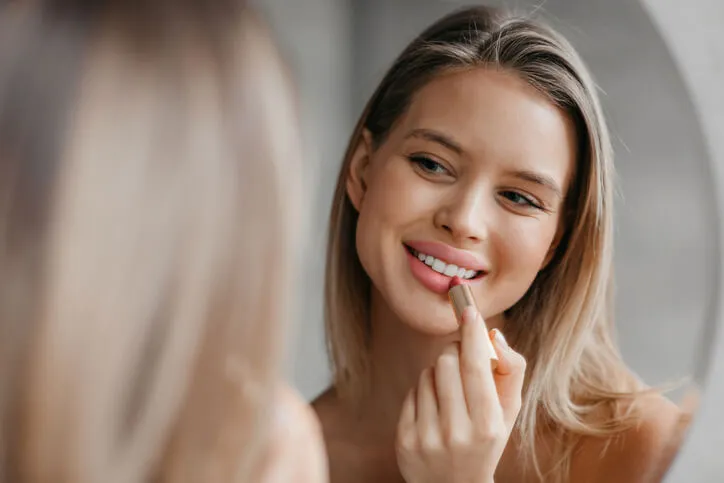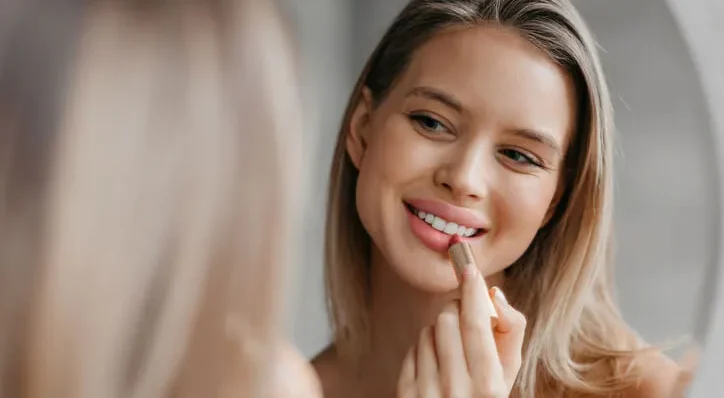In the realm of beauty and cosmetics, lipstick stands as an iconic symbol of femininity, confidence, and style. With its ability to transform a look instantly, it has become a staple in many women’s daily routines. However, beyond its aesthetic appeal, there’s a question that often lingers: what impact does lipstick have on oral health? While the allure of the perfect pout may be irresistible, it’s essential to delve into the science behind lipstick and its potential effects on our oral well-being.

Table of Contents
ToggleUnderstanding Lipstick Composition
Before we delve into the relationship between lipstick and oral health, let’s first understand what lipstick is made of. Lipstick typically comprises a blend of waxes, oils, pigments, and emollients. These ingredients not only provide color but also contribute to the texture, longevity, and overall performance of the product.
Common ingredients found in lipstick include:
- Waxes
- Oils
- Pigments
- Emollients
Waxes
Beeswax, carnauba wax, and candelilla wax are often used to give lipstick its solid form and structure.
Oils
Various oils such as castor oil, jojoba oil, and mineral oil are added to enhance the spreadability and moisturizing properties of lipstick.
Pigments
These are responsible for the color of the lipstick and can be derived from natural or synthetic sources.
Emollients
Ingredients like lanolin, shea butter, and cocoa butter are incorporated to provide hydration and prevent lips from drying out.
While these components contribute to the allure of lipstick, they also raise questions about their interaction with oral health.
The Potential Impact on Oral Health
- Ingestion of Ingredients
- Potential Irritation
- Impact on Dental Health
Ingestion of Ingredients
One of the primary concerns regarding lipstick is the potential for ingestion of its ingredients. Throughout the day, especially during activities like eating and drinking, lipstick can transfer from the lips to the oral cavity. This raises the question of whether the ingredients in lipstick are safe for ingestion in small quantities over time.
While regulatory bodies such as the FDA (Food and Drug Administration) monitor the safety of cosmetic ingredients, some individuals may still be wary of the long-term effects of regular lipstick use. Certain ingredients, such as preservatives or dyes, may cause allergic reactions or sensitivity in some individuals.
Potential Irritation
Another aspect to consider is the potential for irritation or inflammation caused by prolonged exposure to lipstick. Some individuals may experience dryness, chapping, or allergic reactions due to certain ingredients present in lipsticks. Additionally, constant application and removal of lipstick can disrupt the natural pH balance of the lips, leading to discomfort or irritation.
Impact on Dental Health
While lipstick primarily comes into contact with the lips, there’s also the potential for it to affect dental health indirectly. For instance, wearing lipstick may inadvertently transfer colorants or oils onto teeth, which could contribute to staining or plaque buildup over time. Moreover, lipstick residue left on drinking glasses or utensils may introduce foreign substances into the mouth, potentially affecting oral flora or causing oral hygiene concerns.
Mitigating Risks and Promoting Oral Health
Despite these potential concerns, it’s important to note that the impact of lipstick on oral health can vary greatly depending on individual factors such as product formulation, usage habits, and overall oral hygiene practices. To minimize any potential risks associated with lipstick use while maintaining optimal oral health, consider the following tips:
- Choose High-Quality Products
- Practice Good Oral Hygiene
- Limit Prolonged Wear
- Stay Hydrated
- Remove Lipstick Properly
- Monitor for Sensitivity
Choose High-Quality Products
Opt for lipsticks from reputable brands known for their quality and safety standards. Look for products that are hypoallergenic, dermatologist-tested, and free from potentially harmful ingredients such as parabens or phthalates.
Practice Good Oral Hygiene
Maintain a regular oral hygiene routine, including brushing teeth twice a day, flossing daily, and visiting the dentist for regular check-ups and cleanings. Proper oral care can help mitigate any potential adverse effects of lipstick on dental health.
Limit Prolonged Wear
While it’s tempting to wear lipstick throughout the day, consider giving your lips a break from time to time. Remove lipstick before bedtime to allow your lips to breathe and regenerate overnight.
Stay Hydrated
Drink plenty of water throughout the day to keep your lips hydrated and prevent dryness or chapping. Hydrated lips are less likely to experience irritation from lipstick.
Remove Lipstick Properly
Use a gentle makeup remover or micellar water to thoroughly remove lipstick at the end of the day. Avoid scrubbing or rubbing harshly, as this can cause unnecessary friction and irritation.
Monitor for Sensitivity
Pay attention to how your lips react to different lipstick formulations. If you experience any signs of irritation or discomfort, discontinue use and consult a dermatologist or allergist if necessary.
Conclusion
While lipstick undoubtedly adds a touch of glamour to our daily routines, it’s essential to be mindful of its potential impact on oral health. By understanding the composition of lipstick, being aware of potential risks, and adopting healthy usage habits, we can enjoy the benefits of this beloved cosmetic staple while safeguarding our oral well-being. Ultimately, striking a balance between beauty and health is key to embracing our unique sense of style while prioritizing self-care from the inside out.
Frequently Asked Questions (FAQs)
What are the health risks of lipstick?
Lipsticks can contain various chemicals, pigments, and preservatives that may pose health concerns with long-term or excessive use. Some studies have found trace amounts of heavy metals like lead, cadmium, and chromium in certain lipsticks. While these are generally present in small amounts considered safe by health authorities, repeated exposure—especially if lipstick is frequently reapplied and accidentally ingested—can add up over time. Additionally, some individuals may experience allergic reactions, dryness, or sensitivity due to fragrances, dyes, or other chemical additives in lipstick formulas.
Is lipstick harmful during a kiss?
For most people, kissing someone wearing lipstick poses no serious health risks. However, there are a few exceptions. If either person has allergies or skin sensitivities, certain ingredients in the lipstick—like fragrances, artificial dyes, or preservatives—can cause irritation or allergic reactions. Also, frequent or aggressive kissing with lipstick on may lead to clogged pores or mild breakouts around the lips for those with acne-prone skin. Sharing lip products, including through kissing, may also increase the risk of transmitting bacteria or viruses, like cold sores (herpes simplex virus).
What are the concerns with lipstick?
The main concerns with lipstick involve ingredient safety, skin irritation, and environmental impact. Some lipsticks include synthetic dyes (like Red 7 Lake), parabens, phthalates, and mineral oils, which are controversial due to potential hormone-disrupting or carcinogenic effects in high doses. There’s also the issue of microplastic pollution from glittery or long-lasting formulas. On the skin level, prolonged use without proper lip care can lead to dryness, chapping, darkening of the lips, or allergic dermatitis. Being mindful of ingredients and choosing reputable brands can minimize these concerns.
Is it rude to tell someone they have lipstick on their teeth?
While it can feel a little awkward, letting someone know they have lipstick on their teeth is generally seen as considerate—if done politely and discreetly. Most people would rather be told than go through an entire event or conversation unaware. A kind gesture, like quietly saying “Hey, just so you know, you’ve got a little lipstick on your teeth,” is usually appreciated more than staying silent.
Is it bad to wear lipstick every day?
Wearing lipstick daily isn’t inherently bad, but it depends on the type of lipstick, how it’s applied and removed, and how well you care for your lips. Matte and long-wear formulas can be drying and should be balanced with regular moisturizing and exfoliation. It’s also important to thoroughly remove lipstick at the end of the day to prevent buildup, discoloration, or clogged lip pores. Using hydrating lipsticks or lip balms underneath, and occasionally giving your lips a “makeup break,” can keep them healthy even with daily use.
Does lipstick contain toxins?
Some lipsticks do contain trace levels of substances that are considered toxic in large doses—such as lead, parabens, or petrochemicals. However, most regulatory agencies, like the FDA and EU health authorities, have strict limits on the amounts allowed in cosmetic products. That said, not all countries regulate cosmetics the same way, and some lower-quality or counterfeit products may contain unsafe levels. Choosing products from trustworthy brands, looking for certifications (like “clean beauty” or “EWG Verified”), and reading ingredient labels can help reduce your exposure to potentially harmful chemicals.
What is the forbidden lipstick?
The term “forbidden lipstick” doesn’t refer to a specific product, but can mean a few different things depending on the context. In beauty history or political discourse, it might describe lipsticks that were banned due to harmful ingredients—like certain dyes or metals—or those worn as acts of defiance (e.g., bright red lipstick during wartime or in feminist movements). It can also refer to colors considered inappropriate in certain cultures or professional settings. In pop culture, it’s sometimes used metaphorically to describe bold, controversial, or attention-grabbing lip choices.
What are the side effects of a lip kiss?
A kiss on the lips, while often harmless, can carry a few minor risks. Saliva exchange can transfer bacteria and viruses, including cold sores (herpes simplex virus), mononucleosis (“mono”), or even the flu. If either person has broken skin, it could potentially lead to infections. In rare cases, someone with highly sensitive skin or allergies may react to lip products (like lipstick or gloss) worn by their partner. However, for most healthy individuals, the occasional lip kiss poses minimal risk and is a normal, enjoyable part of human connection.
Can lipstick mess up your lips?
Yes, especially if overused or if poor-quality products are applied. Lipstick—particularly matte, long-wear, or drying formulas—can lead to chapped, flaky, or discolored lips over time. Not removing lipstick thoroughly before bed can also cause buildup, clogged pores around the mouth, or pigmentation changes. Some people may develop contact dermatitis or allergic reactions to certain ingredients. To prevent damage, it’s important to exfoliate lips gently once a week, apply a nourishing balm regularly, and use lipstick formulas that contain moisturizing ingredients like shea butter, vitamin E, or hyaluronic acid.

